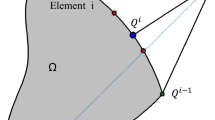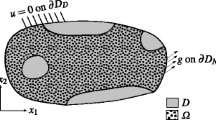Abstract
Erosion of structure may result in non-trivial loss of performance. For instance, erosion may make structure members break apart and results in localized vibration eigenmodes, which will make the first eigenfrequency of eroded structure become smaller. To obtain a robust design whose first eigenfrequency is not disproportionately affected by boundary erosion, we first examine a generic deterministic structural optimization problem defined in the level-set framework. Relying on the analysis of the first-order shape derivative and the optimality conditions, several important conclusions are obtained. Then, the optimization problem of maximizing the first eigenfrequency of structures subjected to uniform erosion is introduced. In each iteration of optimization, erosion is intentionally created, and a mode recognition technique is employed to identify the actual first eigenfrequency, i.e., not belonging to localized eigenmodes. The boundary of the un-eroded structure is optimized to improve the performance of the eroded structure. The shape derivative defined on the boundary of the eroded structure is mapped to the boundary of the un-eroded one by resorting to velocity extension of the level set method.

















Similar content being viewed by others
References
Jansen M, Lazarov BS, Schevenels M, Sigmund O (2013) On the similarities between micro/nano lithography and topology optimization projection methods. Struct Multidiscip Optim 48:717–730
Lazarov BS, Wang F, Sigmund O (2016) Length scale and manufacturability in density-based topology optimization. Arch Appl Mech 86:189–218
Zhou M, Lazarov BS, Sigmund O (2014) Topology optimization for optical projection lithography with manufacturing uncertainties. Appl Opt 53:2720–2729
Wang F, Lazarov BS, Sigmund O (2011) On projection methods, convergence and robust formulations in topology optimization. Struct Multidiscip Optim 43:767–784
Sigmund O (2009) Manufacturing tolerant topology optimization. Acta Mech Sin 25:227–239
Allaire G, Dapogny C (2014) A linearized approach to worst-case design in parametric and geometric shape optimization. Math Models Methods Appl Sci 24:2199–2257
Guo X, Zhang W, Zhang L (2013) Robust structural topology optimization considering boundary uncertainties. Comput Methods Appl Mech Eng 253:356–368
Jang G, van Dijk NP, van Keulen F (2012) Topology optimization of MEMS considering etching uncertainties using the level-set method. Int J Numer Meth Eng 92:571–588
Jansen M, Lombaert G, Schevenels M (2015) Robust topology optimization of structures with imperfect geometry based on geometric nonlinear analysis. Comput Methods Appl Mech Eng 285:452–467
Lazarov BS, Schevenels M, Sigmund O (2012) Topology optimization with geometric uncertainties by perturbation techniques. Int J Numer Meth Eng 90:1321–1336
Schevenels M, Lazarov BS, Sigmund O (2011) Robust topology optimization accounting for spatially varying manufacturing errors. Comput Methods Appl Mech Eng 200:3613–3627
Wang F, Jensen JS, Sigmund O (2012) High-performance slow light photonic crystal waveguides with topology optimized or circular-hole based material layouts. Photonics Nanostruct Fundam Appl 10:378–388
Chen S, Chen W (2011) A new level-set based approach to shape and topology optimization under geometric uncertainty. Struct Multidiscip Optim 44:1–18
Lazarov BS, Schevenels M, Sigmund O (2012) Topology optimization considering material and geometric uncertainties using stochastic collocation methods. Struct Multidiscip Optim 46:597–612
Christiansen RE, Lazarov BS, Jensen JS, Sigmund O (2015) Creating geometrically robust designs for highly sensitive problems using topology optimization. Struct Multidiscip Optim 52:737–754
Yoon GH (2010) Structural topology optimization for frequency response problem using model reduction schemes. Comput Methods Appl Mech Eng 199:1744–1763
Li Z, Shi T, Xia Q (2017) Eliminate localized eigenmodes in level set based topology optimization for the maximization of the first eigenfrequency of vibration. Adv Eng Softw 107:59–70
Choi KK, Kim NH (2005) Structural sensitivity analysis and optimization 1: linear systems. Springer, New York
Haug E, Choi K, Komkov V (1986) Design sensitivity analysis of structural systems. Academic Press, Orlando, FL
Sokolowski J, Zolesio J (1992) Introduction to shape optimization: shape sensitivity analysis. In springer series in computational mathematics vol 16. Springer, New York
Guo X, Zhang W, Wang MY, Wei P (2011) Stress-related topology optimization via level set approach. Comput Methods Appl Mech Eng 200:3439–3452
Peng D, Merriman B, Osher S, Zhao H, Kang M (1999) A PDE-based fast local level set method. J Comput Phys 155:410–438
Osher S, Fedkiw R (2002) Level set methods and dynamic implicit surfaces. Springer, New York
Nocedal J, Wright SJ (1999) Numerical optimization. Springer, New York
Osher SJ, Santosa F (2001) Level set methods for optimization problems involving geometry and constraints. J Comput Phys 171:272–288
Díaaz AR, Kikuchi N (1992) Solutions to shape and topology eigenvalue optimization problems using a homogenization method. Int J Numer Meth Eng 35:1487–1502
Tenek LH, Hagiwara I (1994) Eigen frequency maximization of plates by optimization of topology using homogenization and mathematical programming. In: JSME international journal. Ser. C, Dynamics, control, robotics, design and manufacturing, vol. 37, pp 667–677
Huang X, Zuo ZH, Xie YM (2010) Evolutionary topological optimization of vibrating continuum structures for natural frequencies. Comput Struct 88:357–364
Allaire G, Jouve F (2005) A level-set method for vibration and multiple loads structural optimization. Comput Methods Appl Mech Eng 194:3269–3290
Pedersen NL (2000) Maximization of eigenvalues using topology optimization. Struct Multidiscip Optim 20:2–11
Du J, Olhoff N (2007) Topological design of freely vibrating continuum structures for maximum values of simple and multiple eigenfrequencies and frequency gaps. Struct Multidiscip Optim 34:91–110
Xia Q, Shi T, Wang MY (2011) A level set based shape and topology optimization method for maximizing the simple or repeated first eigenvalue of structure vibration. Struct Multidiscip Optim 43:473–485
Guo X, Zhang W, Zhong W (2014) Doing topology optimization explicitly and geometrically—a new moving morphable components based framework. J Appl Mech 81:081001–081009
Zhang W, Li D, Yuan J, Song J, Guo X (2017) A new three-dimensional topology optimization method based on moving morphable components (MMCs). Comput Mech 59:647–665
Zhang W, Chen J, Zhu X, Zhou J, Xue D, Lei X, Guo X (2017) Explicit three dimensional topology optimization via Moving Morphable Void (MMV) approach. Comput Methods Appl Mech Eng 322:590–614
Allaire G, Jouve F, Toader A (2002) A level-set method for shape optimization. C R Acad Sci ParisSerie I 334:1–6
Allaire G, Jouve F, Toader A (2004) Structural optimization using sensitivity analysis and a level-set method. J Comput Phys 194:363–393
Sethian JA, Wiegmann A (2000) Structural boundary design via level set and immersed interface methods. J Comput Phys 163:489–528
Wang MY, Wang X, Guo D (2003) A level set method for structural topology optimization. Comput Methods Appl Mech Eng 192:227–246
Xia Q, Xia L, Shi T (2017) Topology optimization of thermal actuator and its support using the level set based multiple–type boundary method and sensitivity analysis based on constrained variational principle. Struct Multidisc Optim. https://doi.org/10.1007/s00158-017-1814-1
Xia Q, Shi T (2016) Optimization of structures with thin-layer functional device on its surface through a level set based multiple-type boundary method. Comput Methods Appl Mech Eng 311:56–70
Xia Q, Shi T (2015) Constraints of distance from boundary to skeleton: for the control of length scale in level set based structural topology optimization. Comput Methods Appl Mech Eng 295:525–542
Xia Q, Wang MY, Shi T (2013) A move limit strategy for level set based structural optimization. Eng Optim 45:1061–1072
Sethian JA (1999) Level set methods and fast marching methods: evolving interfaces in computational geometry, fluid mechanics, computer vision, and materials science, 2nd edn. Cambridge monographs on applied and computational mathematics. Cambridge University Press, Cambridge
Xia Q, Shi T, Liu S, Wang MY (2012) A level set solution to the stress-based structural shape and topology optimization. Comput Struct 90:55–64
Acknowledgements
This research work is supported by the National Natural Science Foundation of China (Grant No. 51575203) and the Natural Science Foundation for Distinguished Young Scholars of Hubei province of China (Grant No. 2017CFA044).
Author information
Authors and Affiliations
Corresponding author
Rights and permissions
About this article
Cite this article
Li, Z., Shi, T., Xia, L. et al. Maximizing the first eigenfrequency of structures subjected to uniform boundary erosion through the level set method. Engineering with Computers 35, 21–33 (2019). https://doi.org/10.1007/s00366-018-0580-z
Received:
Accepted:
Published:
Issue Date:
DOI: https://doi.org/10.1007/s00366-018-0580-z




